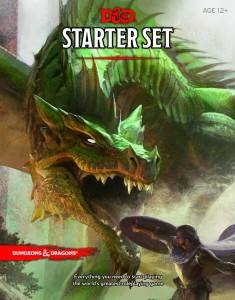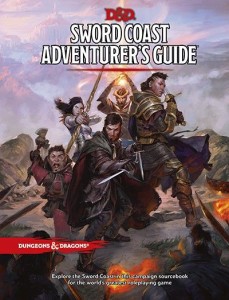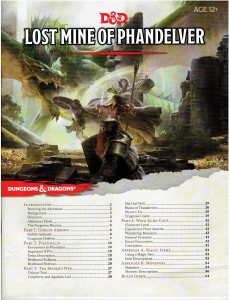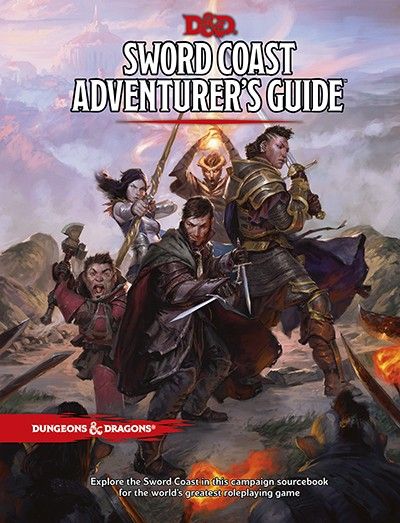It has been a while since I played Dungeons & Dragons with any regularity, and even longer since I led a campaign as a dungeon master (or DM). With the new 5th edition rules and my older son showing an interest, this was a perfect time to get back into the game.
 Because I was still learning the new rules and leading a group of players who had not played before (well, except for one) I wanted to make it easy on myself and had picked up the Starter Set which included an adventure specifically designed for players to start out with. After two sessions of play we are about a third of the way through the included adventure – The Lost Mine Of Phandelver.
Because I was still learning the new rules and leading a group of players who had not played before (well, except for one) I wanted to make it easy on myself and had picked up the Starter Set which included an adventure specifically designed for players to start out with. After two sessions of play we are about a third of the way through the included adventure – The Lost Mine Of Phandelver.
When I was playing regularly the official scenario for Dungeons & Dragons was World of Greyhawk. Many of the modules I played through “back in the day” are set in this world. I only dipped my toes (metaphorically) in the Dragonlance setting as that is about when I stopped playing initially. When the 3.5 edition rules came out I played a little, but I am not sure what the game world was. That never really came up.
I am sticking with the official game setting because not only is it where the adventure in the Starter Set is located, but also the follow-up adventures starting with Hoard Of The Dragon Queen. The Forgotten Realms may not be where I cut my teeth but it is just the setting. Fortunately it comes ready-made with a rich backstory and several products to have adventures.
My group? Well, They don’t know anything about all of this. All they know is they are currently slaying some goblins.
And that is why I am happy to stick with the Forgotten Realms setting and official adventures. Much of the legwork for creating a campaign is already done. Teaching a group of middle schoolers how to play while simultaneously getting familiar with the new 5th edition rules is more than enough. I don’t need to be creating a game world and adventures on top of all this. Yet.
In an attempt to make the game go smoothly I am not worrying too much about strict adherence to the rules. I am easing myself and the young adventurers into this. One tactic that I have found fun is when the attack roll lands on a natural 1 or 20. Critical failure will result in somebody getting hurt. Imagine a sword slipping out of a fighter’s hands and landing point down on their foot. Perhaps a magician’s staff backfires. Whatever it is, I make sure the damage isn’t too severe and describe the mishap in a humorous manner. Alternately, when a natural 20 occurs on an attack roll, I allow for two rolls of the damage dice to be dealt, and if warranted, a wonderfully entertaining exposition of the action. Especially if it results in the death of an enemy monster.
And yes, I roll a couple of dice randomly behind the dungeon master’s screen as if some random event might take place. Just to keep them on their toes.
 Wizards Of The Coast has, in addition to the Player’s Handbook, Monster Manual and Dungeon Master’s Guide, a 4th book about to be released. The Sword Coast Adventurer’s Guide will have a lot about the region currently the focus of the multiple published adventures. Included in the book will be not only geography and history, but also a bit about the various races, including information not found in the Player’s Handbook. I am looking forward to having this tome in my hands to further enrich the campaign.
Wizards Of The Coast has, in addition to the Player’s Handbook, Monster Manual and Dungeon Master’s Guide, a 4th book about to be released. The Sword Coast Adventurer’s Guide will have a lot about the region currently the focus of the multiple published adventures. Included in the book will be not only geography and history, but also a bit about the various races, including information not found in the Player’s Handbook. I am looking forward to having this tome in my hands to further enrich the campaign.
Several of the NPCs (non-player characters, for those who do not know) in the adventure included in the Starter Set will attempt to recruit the players into their different alliances. Apparently there are different alliances along the Sword Coast, each with their own goals, motivations and strategies. This is one of the ways where having the Sword Coast Adventurer’s Guide will be most helpful, and I wish I had it before setting out on the adventure with the group.
With two sessions under out collective belts, I think we are all getting the hang of the game. Well, for my part I am getting used to the new rules. There is one friend of August’s who has played before but that was 4th edition. The new ruleset is taking some getting used to on his part as well. The players started off with what should have been a routine escort mission, only to find themselves ambushed by goblins. The NPC fighter character I had (because nobody had picked a character of the “muscle” variety) wound up saving the rogue’s life during the ambush by taking a couple of arrows and quickly making short work of the troublemakers.
 Rather than follow the trail the goblins left (despite goblins being a favored enemy of the ranger character) the party went on to the town only to find their employer was missing. It took a little while, but they figured it out and the next day they went back to the ambush site to follow the trail.
Rather than follow the trail the goblins left (despite goblins being a favored enemy of the ranger character) the party went on to the town only to find their employer was missing. It took a little while, but they figured it out and the next day they went back to the ambush site to follow the trail.
Entering the goblin lair the party immediately took to slaying the foes in front of them. This meant an alternate passage, a sort of “back door” opened up allowing for an advantageous surprise attack on what should have been a most bothersome battle. Because one of the players had to miss the second session it was easy to temporarily have his character removed from play – he fell down from the vantage point and was knocked unconscious.
Because I wanted to see what the players would do, I altered the scenario slightly. Instead of rescuing the NPC at 1 hit point, I made him unconscious as well, just to see how the characters would react. Not only do they have crates of goods to take back to town, but two additional characters that need transporting. Unfortunately after the goblin lair was cleared out the second session ended and we didn’t get to fully resolve that issue.
There is still plenty of adventure left in the scenario presented in the Starter Set, at least 3 or 4 sessions the rate we are going, which isn’t necessarily a bad thing. I am eager to see if a bit of practice will get these kids to think beyond the immediate threat of an enemy in front of them and put the puzzle pieces together of the “ordinary” encounters with townsfolk and the like to not only follow the story trail to the next encounter but to get through the overall story.

